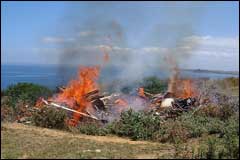|
|
|||
|
||||
|
Updated: September 6, 2001 |
|
|
|||||||||||||||||||||||||||||||||||||||||||||||||||||||||||||||||||||||||||||||||||||
 Weeds are often burnt to prevent regrowth or seed germination |
|
|
A team of DoC staff were brought together to work on eliminating plant pests on Tiritiri Matangi over the summer 2000- 2001.
In November the team focussed on eliminating Japanese Honey Suckle. This weed grows over regenerating trees and shrubs and stops their growth. The honeysuckle plants were found through searching over 150 ha of the island in a grid pattern. The weeds were then sprayed with a herbicide.
Other weeds that were targeted included mothplant, banana passionfruit, Mexican devil and periwinkle. Most of these were sprayed but Mexican devil was hand pulled.
Stage two focussed on controlling boxthorn growing on the north-eastern side of the island. This hardy shrub was introduced from South Africa and shades young seedlings from the sun. This year's plants were sprayed and dead boxthorn from last year's project was gathered and burnt. Sweet pea and pampas grass were also sprayed during stage two.
Weed control is important to allow native plants the sunlight and ground space to grow without competition by introduced species.